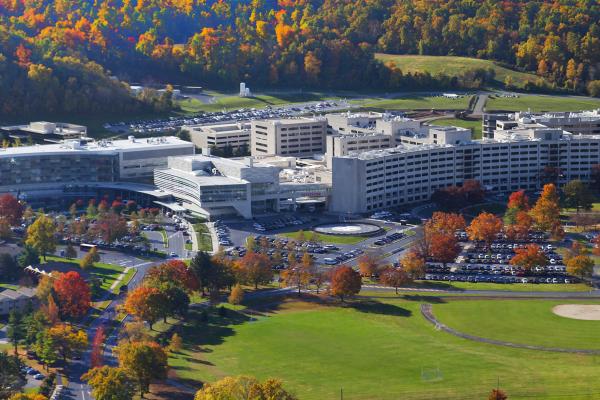Common Enlarged Prostate Condition
The prostate is a male reproductive gland that produces fluid in semen. The prostate wraps around the urethra, which is the tube that transports urine out of the bladder. An enlarged prostate compresses the urethra and interferes with urine flow, overworking the bladder and eventually causing it to weaken.
Benign prostate hyperplasia (BPH) is not cancerous – it simply means you have an enlarged prostate gland. BPH is common, affecting approximately half of men by age 50 and up to 90% of men over the age of 80.
Symptoms, Diagnosis and Outlook
An enlarged prostate can cause urination problems. Symptoms of an enlarged prostate include:
- Delayed, interrupted or weak urine stream
- Increased urination frequency or urgency
- Kidney infections
- Kidney stones
- Urinary retention or incontinence
At Penn State Health, our team of urology experts is here to diagnose an enlarged prostate. During your appointment, your care team will review your health history and discuss behaviors that may impact your symptoms. You will also have a rectal exam to gauge the size, shape and tenderness of your prostate.
Your doctor might also order the following diagnostic tests:
- Urinalysis: a urine test to detect a urinary tract infection or blood in the urine
- Prostate-specific antigen: a blood test that measures a specific protein that can be elevated in men with an enlarged prostate, prostate cancer or other prostate conditions
- Urine cytology: a urine test to screen for bladder cancer
- Genitourinary ultrasonography: an ultrasound to rule out an obstruction
- Post-void residual urine volume: a test that measures how much urine remains in your bladder after urination
- Urethrocystoscopy: a visual exam of the urinary tract using an instrument called an endoscope
- Urodynamics: an office test that determines how well your bladder functions and how severe your obstruction might be
Many men with BPH do not have bothersome symptoms. If this is the case, your urologist will regularly monitor you for worsening symptoms. Lifestyle changes such as limiting liquids before sleep or cutting back on caffeine or alcohol can be beneficial in relieving symptoms.
The outlook for patients with worsening symptoms is positive with medications. Side effects to these medications may include low blood pressure, decreased libido and dizziness. In cases where patients do not respond to medicine, a minimally invasive procedure or surgery may be recommended.
Experts in Care
Meet our doctors, view their profiles and select the one that’s right for you.
Find a doctor near youWhy Choose Penn State Health for Care
The surgical urological team at Penn State Health offers a full range of office-based and minimally invasive surgical treatments for an enlarged prostate.
Comprehensive Treatment Options
The Penn State Health urology team provides patients with comprehensive, minimally invasive surgical treatment options and ongoing multidisciplinary care. Our fellowship-trained urologists will develop a personalized treatment plan to help provide symptom relief and improve your quality of life. Our team will work with you to determine the right procedure, factoring in the size of your prostate, your age, the amount of discomfort you are experiencing and any additional medical conditions.
Medications for Benign Prostate Hyperplasia
Medications to relax or shrink the prostate include alpha blockers, 5-alpha-reductase inhibitors or a combination of both. These are typically the first line of defense for an enlarged prostate. However, sometimes medications are not effective or lose their effectiveness over time. The Penn State Health urology team will work with you to find the right medication combination to shrink your prostate and minimize your symptoms.
Transurethral Resection of the Prostate (TURP)
Transurethral resection of the prostate (TURP) is the gold standard for enlarged prostate surgery. An electrical cautery loop shaves chips off the inside of the prostate gland, where they are carried to the bladder with fluid and flushed out of the body. The TURP procedure requires general or spinal anesthesia and a one-night hospital stay. Catheterization is usually necessary for several days following the procedure. Patients can experience retrograde ejaculation (dry orgasms) after TURP.
Minimally Invasive Surgical Treatments
At Penn State Health, our urologists may recommend a state-of-the-art, minimally-invasive surgical treatment. Most prostate surgeries use the transurethral approach, which is when a device is inserted through the penis and urethra to reach the prostate. No surgical incision is necessary.
The minimally invasive surgical options available at Penn State Health include:
- Holmium laser enucleation of prostate (HoLEP): A laser is used to remove overgrown tissue from the prostate, which is pushed into the bladder and removed. The procedure can be used for an enlarged prostate of any size, but is particularly effective for very large prostates. The HoLEP procedure can be performed in an outpatient setting and has a low likelihood of postprocedural bleeding, making it a good option for patients with bleeding disorders. The procedure also removes more excess prostate tissue than other procedures, giving it the lowest reoperation rate (1% to 2%). Patients can experience retrograde ejaculation (dry orgasms) after HoLEP.
- GreenLight laser therapy: High-powered green light laser pulses are aimed at excess prostate tissues. Red blood cells in the tissue absorb the light and heat up, causing the tissue to vaporize and be irrigated from the bladder. Also called photoselective vaporization of the prostate, this technique seals off blood vessels, resulting in lower bleeding rates. Our Penn State Health team uses the latest-generation GreenLight laser device. Most patients can go home the same day of their procedure. About one-third of patients experience retrograde ejaculation with the GreenLight laser therapy.
- Transurethral Resection of the Prostate (TURP): An electrical cautery loop shaves small amounts of tissue off the inside of the prostate gland, where they are carried to the bladder with fluid and flushed out of the body. The TURP procedure requires general or spinal anesthesia and a one-night hospital stay. Catheterization is usually necessary for several days following the procedure. Patients can experience retrograde ejaculation (dry orgasms) after TURP.
- UroLift system: The UroLift system is one of the newest minimally invasive techniques for treating an enlarged prostate. In this quick outpatient procedure, small implants are inserted to hold the prostate lobes open, making more room for urine to flow through the urethra. It takes less than an hour to perform the procedure and has the shortest recovery. The procedure has expanded to include men younger than 45 years old. The UroLift preserves both erectile and ejaculatory function and does not rule out other treatment options like TURP, HoLEP or GreenLight laser in the future, if necessary.
Support Groups
Support groups provide an opportunity to share your feelings and connect with other patients and caregivers who are experiencing similar struggles.
Convenient Locations
Find the care your family needs, close to home, at one of our many locations throughout central Pennsylvania.
Find a location near you



